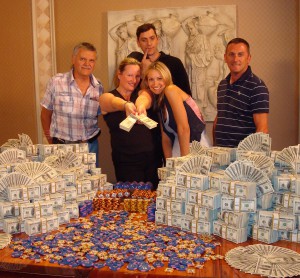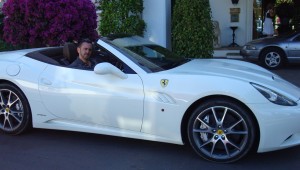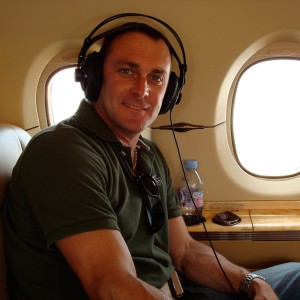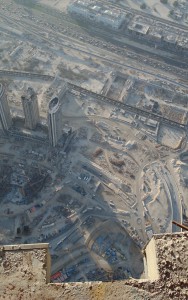Helicopters, Private Jets, Super Yachts and Fast Cars
Paul Keyworth MIBS describe his experiences working on making the TV interview series ‘Piers Morgan on…’
It all began, rather conventionally as a three half-hour ITV1 documentary series on Sandbanks in Dorset – apparently the most expensive real estate area of the UK – involving a fairly straightforward look at the characters that made this place ‘Britain’s Monte Carlo.’ Football Manager Harry Redknapp, Property Tycoon Tom Doyle, and Bar Owner and ‘bad-lad’ Ian Davis, all showed former Daily Mirror Editor Piers Morgan around the small enclave of Britain’s rich, but not necessarily famous, houses, super yachts and fast cars. During the on-camera conversations Piers dug below the surface and asked the sometimes awkward questions to try to peel off the layers of this exclusive corner of the South coast. With two weeks to shoot, and most interviews and sequences shot on two cameras, the schedule was busy but manageable. ITV and the audience liked the end result, and so the following summer we commenced a three part series, this time looking at the ‘real’ Monte Carlo, Hollywood and Dubai. At the time of the original UK-based series Piers’ TV career hadn’t risen to its current dizzying heights, but by the time of the first international series his availability was seriously limited and there were just four days to shoot one hour of ITV1 primetime – and by now the production had made the forward thinking decision to record in HD in order to maximise international sales. This was definitely one of those productions that required as much flexibility as a tight PSC budget allowed: two cameramen, one sound recordist and no assistants!
Technology
The main interviews and sequences were covered with two Sony HDW790 cameras, and I decided to hard-wire from my trusty SQN4s IVe to both cameras via a Ravenscroft camera splitter. The cameras were usually timecode sync’d using my Blackbox timecode TX/RX. Although it would have been nice to have the flexibility of a hard drive recorder and to work wirelessly, I needed to be able to work at full speed and not worry that sound might not have been getting to the cameras. Additionally, I didn’t want to have all the hassle of at least three radio mic receivers and two camera transmitters, plus an additional Trantec IEM transmitter as a director’s feed, all in my mixer bag in countries where rock-solid radio mic reception could not be guaranteed.
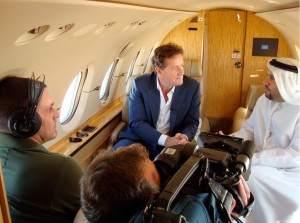
Filming Dr Sulaiman Al Fahim, one of the men behind the takeover of Manchester City Football Club and presenter of Dubai's version of "The Apprentice"
Many of the interviews were shot hand-held in one take, and often while walking around large houses or gardens with the cameras either cross shooting or one would be shooting wide shots. So everything had to be done on radio mics. I use Audio 2040 or 2020 transmitters with Tram Tr50 mics, which were almost always concealed under the central placket of dress shirts. Piers tended to wear crisp, open-necked white shirts, requiring very careful positioning of the Trams. I generally used either a Tram tape-down holder with double-sided toupee tape on the back of the tape-down, or a vampire clip, and I placed the mic just out of sight between the second and third buttons. A slight tweak of the fabric to keep the two layers of the shirt from rubbing together tended to work quite well, and if necessary I’d add a Tram windshield and move the mic about 1cm to keep the windshield out of shot.
I have tried the Tram boundary-layer holder which has a couple of small metal arches on a small plastic disc to keep clothing away from the capsule, but I find the whole clip too bulky and often no better than the standard tape-down at reducing rustle. I also think the plastic disc has strange effects on the frequency response of the Tram, by reducing the LF and making the mic too ‘toppy’. If Piers or the guest wore a jacket then I sometimes placed the mic under the jacket lapel, again just out of shot, but this time slightly higher up than the second/third button and at the point where the jacket lifts away from the shirt at the top of the breast bone.
Flying Sound Service
Once or twice per show we would do interviews or pieces to camera (PTC) in a participant’s fast sports cars, or in the manufacturer-loaned premium sports car that Piers drove around town in. As these cars tended to be two-seaters with hardly any passenger space in the back, the interviews or PTCs were shot on an Iconix HD-RH1 HD minicam and recorded on a Sony HDWS280 portable deck. For these situations, where it was impossible to be in the car whilst the interview was in progress, I opted to put the ‘talent’ on ECM 77s hard-wired into a Sound Devices Mix-Pre, and from that into the HDW S280. I was reluctant to use radio mics so close to those big, throaty, unsuppressed sports car engines, and since it was impossible to confidently monitor the recording I best-guessed or did a quick test drive to set the levels… and then took them down by about 6dB so that any raised voices wouldn’t distort. I remember only one occasion, where a wannabe racing driver took a hairpin bend up in the hills above Monaco much faster than Piers was expecting and the car twitched perilously close to a crash barrier, that Piers’ expletives gave the limiters more than they could handle!
Although I still wanted to have the mics hidden, in the car situation I tried to go for a much closer mic position with the ECM 77’s, sometimes biasing the placing of the mic left or right of centre so that when one person turned their head and spoke to the other they were much more ‘on mic’ than a central mic placement would have given. It was, of course, always necessary to check that when the people were sat in the cars their mics were well away from the seatbelts. I invariably used one of the small foam windshields that come with the Rycote Lavaliere Windjammers on the ECM77s; they are discrete enough under clothing for the demands of HD and, personally, I think better than the standard ECM77 cage windgag. They are effective enough for reducing the fairly small turbulence that these supercars have in the lower half of the cockpit – after all, these cars are designed to put the wind in your hair and the g-force in your chest, not the other way around! Whenever we had to film inside helicopters, most often for opening or closing PTCs, then I would use the same ECM77 and Sound Devices Mix-Pre rig, taping an ECM77 very close to the boom mic of Piers’ headset. I find the distortion and vox-switching inherent with the Peltor headset mics to be too distracting and often not clean enough to be intelligible for broadcast. However, where I had the time and the opportunity I used a custom NATO to XLR lead that I had made up for me, and plugged that into the intercom circuit to feed the second channel of the Mix Pre, and split track that to the camera. That gave the editor or dubbing mixer the chance of mixing in a little bit of the intercom sound, which I think helps to add reality to helicopter PTCs.
Fluid Scheduling
One of the constant factors of this series was its highly fluid scheduling. Piers probably has one of the best ‘little black books’ in the business, and if he found out that a celebrity was in town he’d be on the phone or PDA chasing an interview. If they said ‘yes’ then it was often a case of cutting our current sequence short and heading off somewhere else in a hurry.
In Monaco Piers persuaded Mohammed al Fayed to let us aboard his beautiful yacht, Sokar (previously named Jonikal). In 2008 it was in the top one hundred largest private yachts in the world, and famous for the pictures of the late Diana, Princess of Wales sunbathing and sitting on the diving board as she enjoyed a holiday with Dodi al Fayed. When those kind of interviews arose there was often absolutely no room for negotiation as to where they were held, and on this occasion Mohammed was sat at the stern of the boat and had three electric fans facing him in an attempt to keep cool in a blisteringly hot day. I could have asked to have the fans switched off, but that risked losing the interview and so I just had to do what I hope all recordists do in those situations – go with the flow. I used a Tram TR50 with a wind-gag taped down under his lightweight shirt, and subtly twisted the fans away as I moved back from the guest, sat down, faded the mics up, listened hard and said, “sound is ready”. Of course, not everything worked perfectly all the time, and there were a few crazy moments. In LA we jumped aboard a 2000hp speed boat called Sexual Chocolate, previously owned by the flamboyant basketball star Denis Rodman but now in the possession of Splash Media photo agency – one of the top celebrity (paparazzi) agencies based there. The director wanted to shoot a 1+2 interview right at the back of the boat, next to the three massive engines, as they bombed along Santa Monica beach. I said I wasn’t sure it was going to work but there was no going back and, to be honest, there wasn’t really any other open space on the boat anyway. As the chat progressed I couldn’t hear a thing – the engines were just so thunderously loud – and needless to say, only the GV’s made the cut. On Series Two I remember having to walk backwards to ‘drop’ a radio mic on to Sylvester Stallone as he emerged from a Las Vegas casino lift. He was being escorted by several enormous bodyguards across the casino floor, and then he immediately sat down at a roulette table and launched into a hilarious interview. No time for pleasantries – I just had to get the mic under his shirt and scurry back to where the cameras were already rolling. On the same shoot Piers fixed a mock wedding between Paris Hilton and himself. She was dressed in a full white wedding gown, but this time it was her dresser that had to wire her up!
In Dubai, a city built on dreams and the shifting financial sands of the credit crunch, we scaled the Burj al Dubai – currently the world’s tallest man made structure. We were allowed onto the (at the time) unfinished 160th floor, 611m above street level, and stood with just the flimsiest plastic webbing barrier between us and the tiny skyscrapers standing way below. During construction the internal lifts only went to the 130th floor, and so we were all bundled into a cage that clung to the outside of the building for the final gut-wrenching thirty floor ascent and decent. My head for heights is pretty good, but terra firma felt most welcome afterwards! After four days of ‘sync’ filming per episode, most of the production team departed leaving just a director and cameraman to mop up all the non-sync GV’s. We typically crammed in twenty locations around the town we were featuring, and the production team would have a better idea of which locations and sequences were going to make it into the edit so could concentrate on those locations. For the rest of us it was hectic and sometimes slightly chaotic, and on a budget that couldn’t be stretched any further – but it was a decent challenge to any recordist. I’m firmly of the belief that on these kinds of productions, if I can get it right first time, 80% of the time, and only ask for a retake when I know the sound is unusable but repeatable, then I can go home and recover and hope I got the balance between perfection and passable just about right.

